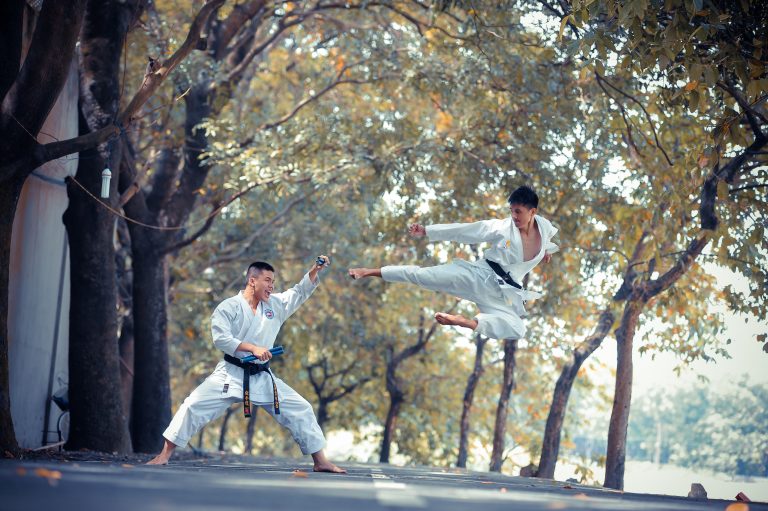Karate Game Rules: Everything You Need to Know
Karate is a combat sport that requires skill, technique, and patience. It originated in Okinawa, Japan in the 19th century and has since gained popularity worldwide. Karate training not only builds physical strength but also trains the mind, body, and spirit to work in harmony.
Karate games offer an opportunity for karate practitioners of all levels to compete with one another. In this article, we will discuss the rules of karate games, how to score points, and some strategies for winning.
Karate Game Types
There are two main types of karate games: Kumite and Kata.
Kumite
Kumite is a sparring competition where two opponents face off against each other. The goal is to score points by hitting the other person with punches, kicks, or strikes. However, there are strict rules in place to ensure that the sparring is safe and fair for both competitors.
Kata
Kata is a non-sparring game where the practitioners perform a series of choreographed movements. The goal is to demonstrate mastery of techniques and movements, as well as focus, balance, and coordination.
Kumite Competition Rules
In a Kumite competition, two competitors will face off against each other in a sparring match. The competition is split into three rounds of two minutes each, with a one-minute break between each round. The goal of Kumite is to score as many points as possible.
Scoring Points
In Kumite, there are three ways to score points:
– Yuko (1 point): A light or glancing contact with a punch, kick, or strike.
– Waza-ari (2 points): A clean and powerful technique that causes the opponent to stumble or lose balance.
– Ippon (3 points): A solid, decisive technique that knocks the opponent down or renders them unable to continue.
Rules of Contact
In Kumite, there are strict rules for making contact with your opponent. Punches and kicks should be aimed at the midsection or above the waistline. Strikes to the head, neck, or groin are strictly prohibited.
If a competitor breaks these rules, they will receive warnings or disqualifications depending on the severity of the infraction.
Judging Criteria
If there is no clear winner after three rounds of Kumite, the judges will decide the winner based on the following criteria:
– The number of points scored.
– The number of warnings or disqualifications.
– The overall performance, including technique, control, and spirit.
Kata Competition Rules
In Kata, competitors perform a series of moves in a choreographed sequence. The competition is judged on the quality and accuracy of the movements, as well as overall performance, focus, balance, and coordination.
Scoring Criteria
In Kata, judges evaluate the competitors on the following criteria:
– Technical Skill: The accuracy and quality of the techniques performed.
– Performance: The overall presentation, including the use of speed, power, balance, and rhythm.
– Focus: The focus and concentration exhibited by the competitor throughout the sequence.
Rules of Kata
In Kata, competitors must follow a pre-determined sequence of movements. Judges will evaluate the competitors‘ ability to perform these movements accurately, with control and fluidity. The use of weapons or partner-assisted techniques is not allowed in Kata competition.
Strategies for Winning
To win a Karate game, practitioners must focus on technique, control, and spirit. Here are some strategies to help you achieve victory:
– Practice: Consistent training is vital to develop techniques and master movements. It’s crucial to work on your accuracy, power, balance, and speed.
– Focus: Maintaining concentration and focus during the game is essential to avoid mistakes and stay in control.
– Anticipate: Try to anticipate your opponent’s moves and be ready to respond quickly.
– Stay calm: Don’t let emotions overpower reason. Instead, try to stay calm, composed, and focused.
– Control: Maintain control throughout the competition, and avoid unnecessary movements or techniques that may lead to disqualification.
Frequently Asked Questions about Karate Game Rules
Karate is a dynamic sport that requires strength, agility, and precision. It involves a lot of discipline, hard work, and dedication. One of the essential aspects of Karate is understanding the various rules that govern the game. In this post, we’ll provide you with answers to the most common questions about Karate game rules.
1. What are the basic rules of Karate?
The following are the fundamental rules of Karate:
– Karate matches consist of three rounds, each lasting for two minutes, with a one-minute rest period between rounds.
– Points are awarded to each player based on the techniques used, and the player with the most points at the end of the match is declared the winner.
– Players get penalties for any violation of the rules, and accumulated penalties can cost the player points or disqualification.
2. What is the objective of Karate?
The primary goal of Karate is to defeat the opponent. Players aim to score the most points by showcasing their skills, techniques, and strategies. The competitor with the highest score at the end of the match is declared the winner.
3. How are points awarded in Karate?
Points are awarded in Karate based on the following factors:
– Valid techniques: A valid technique is a legal move that hits the designated target areas of the body. A single blow earns one point, and a combination blow can earn multiple points.
– Control: Points are awarded for showing control over the technique used by the player.
– Sporting attitude: Points are added or deducted based on the player’s sportsmanship, attitude, and conduct during the match.
4. What are the different types of Karate techniques?
There are three primary types of Karate techniques:
– Kicks: Any technique that involves the use of the legs.
– Strikes: Any technique that involves the use of the hands.
– Blocks: Any technique that involves the use of the arms or legs to block an incoming attack.
There are numerous sub-types of these techniques, depending on where the attack or defense is targeted.
5. What are some common fouls in Karate?
Here are some of the most common fouls in Karate:
– Attacking the opponent’s face, throat, or groin area.
– Attacking an already fallen opponent.
– Using illegal techniques that are not sanctioned by the sport’s governing bodies.
– Grabbing, pushing, or pulling the opponent’s uniform.
These fouls can result in the imposition of penalties, deduction of points, or even disqualification.
6. What is the role of the referee in Karate?
The referee plays a crucial role in ensuring that the match is conducted according to the rules of the sport. The referee is responsible for awarding points, imposing penalties, and disqualifying players, if necessary. The referee also ensures that the match is conducted safely and that no player is seriously injured during the match.
7. What happens in the event of a tie?
In the event of a tie, an additional round is played. If there is still no clear winner, the judges make the final decision by awarding the victory to the player they consider to have performed better during the match.
8. What are some strategies used in Karate?
Here are some common strategies used in Karate:
– Attacking the opponent’s weak points to gain an advantage.
– Using a fake attack to mislead the opponent and create an opening.
– Timing the attack perfectly to catch the opponent off-guard.
– Dodging the opponent’s attack and counterattacking.
Overall, Karate is an exciting and physically demanding sport that requires a lot of skill and technique. Knowing the fundamental rules, techniques, and strategies is essential for success in the sport. We hope that this post has answered all your questions about Karate game rules.
Karate Game Rules: A Comprehensive Guide to Playing Karate Games
If you’re interested in playing karate games, it’s important to know the basic rules and regulations of the game. Karate games can be played in different ways, so understanding the rules can help ensure you have fun while playing while also staying safe. Here, we’ll provide a comprehensive guide on the essential rules of karate games to help you play the game like a professional.
Materials and How to Set Up
Before beginning, you’ll need to ensure you have enough space for your game. Clear a large area in the room, ideally one that is spacious and has sturdy walls. You’ll also need to make sure you have clean and appropriate gear, including karate uniforms, helmets, gloves, and pads.
Players should stand on opposite sides of the room, and each player should wear a uniform that’s the same color as their respective flags. The flags should be placed on opposite sides of the room so that the players have to cross the room to get to the other flag.
Gameplay Basics
The objective of the game is simple: players must snatch the opponent’s flag, while trying to avoid allowing their own flag to be taken. Before the game begins, players will have three minutes to strategize with their teammates on how to execute their plan of capturing their opponent’s flag. When the game begins, players will have the opportunity to take possession of the opponent’s flag.
Players can use karate techniques to distract and impede their opponents‘ progress. Fighting and tackling is not allowed during gameplay, but other moves like blocking, dodging, and evading should be used to intercept the opponent.
Scoring System
Points are awarded to the player snagging the opponent’s flag and successfully bringing it back to their side of the room without being defeated. The game ends when one of the teams has scored more points than their opponents, leading to the opposite team’s defeat.
Rules of the Game
Players must follow specific rules when playing karate games. These include:
1. Blocking: Players are allowed to use their own techniques to block their opponents. To prevent a foul or disqualification, players should avoid direct physical contact that could result in injury.
2. Tackling: Players are not allowed to tackle the opponent. Doing so might result in serious injury or disqualification.
3. Fighting: Fighting is prohibited, and any players who engage in physical contact will be disqualified from the game.
4. Scoring: When a player successfully captures their opponent’s flag, they will receive one point. The first team to get to ten points wins the game.
5. Time Limit: Every game session will last for ten minutes unless otherwise specified by the game supervisor.
6. Equipment: Players should be in full karate gear, including gloves, pads, and helmets. Wearing the right gear can help prevent accidents and injuries.
Conclusion
Karate games are a unique and exciting way to experience the martial arts discipline. Ideal for any group of karate enthusiasts, it is a game that requires strategy, speed, and agility. This guide to the essential rules and regulations of karate games should help you play the game like an expert in no time. Remember to always prioritize safety, play fair, and have fun.
Inhaltsverzeichnis





